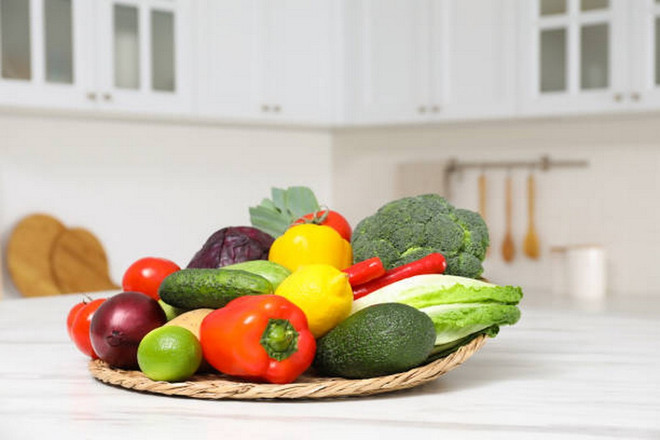Everyone knows that eating vegetables is good for health, but few people realize how important they are. Vegetables are a “living storehouse of nutrients” that provide essential vitamins, minerals and antioxidants - factors that help the body prevent a series of chronic diseases such as cardiovascular disease, diabetes and cancer.
Studies show that people who eat a wide variety of vegetables have a significantly lower risk of disease, and maintain a healthy weight, skin, and immune system. Each color of vegetable – from green, orange to red – contains a different group of nutrients, so the more colorful your plate is, the more comprehensively protected your body is.
However, despite knowing the benefits of vegetables and fruits, many of us still do not eat enough of them every day. To make eating more vegetables a natural and enjoyable thing, please refer to the following 8 ways:
Smart meal planning
A healthy diet starts with planning. Preparing your weekly menu in advance helps you proactively add the necessary amount of vegetables, avoiding the temptation to indulge in fast food meals that lack nutrition.
Make a detailed list of vegetable dishes for each meal, prioritize using fresh vegetables at the beginning of the week and store the rest in the refrigerator or freezer. Washing, cutting and preparing vegetables together as a family is also a great way to bond and inspire cooking.
You can use meal tracking apps to remind you to eat your daily servings of vegetables. When everything is prepped in the fridge, eating more vegetables becomes a lot easier.
Start your day with fruits and vegetables

Breakfast is the perfect time to add vegetables without much effort. A green smoothie with banana, apple and spinach can provide energy and fiber for the whole morning.
You can also add cherry tomatoes and sprouts to your sandwich; or eat fruit salad with walnuts and almonds. According to nutritional recommendations, just by maintaining this habit, you have completed more than half of the recommended daily intake of fruits and vegetables.
Turn vegetables into a highlight in the kitchen
When fruits and vegetables are placed front and center in the kitchen, they naturally become your first choice.
A bright plate of fresh fruit in the middle of the dining table, a few colorful containers of vegetables in the refrigerator - these small details create a healthy and inspiring atmosphere. For young children, regularly seeing and being exposed to vegetables also helps form positive eating habits early.

Add vegetables to familiar dishes
One of the easiest ways to increase the amount of vegetables in your diet is to start with foods you are already familiar with. If you regularly eat rice, noodles, pasta, or stir-fries, try adding some vegetables to these dishes. You can add vegetables to soups, salads, or even make crispy fried vegetables as a side dish.
Adding vegetables to familiar dishes won't make much of a difference, but it will make it easier to eat more vegetables without feeling overwhelmed.
Frozen vegetables
If you are busy, frozen vegetables are a real “savior”. Many studies show that frozen vegetables retain almost all the nutrients as fresh vegetables, and are even fresher if frozen immediately after harvest.
You can store peas, broccoli, and carrots in the freezer for quick soups, stir-fries, or boiling when needed.

Before packaging and freezing, vegetables should be pre-processed such as cleaning, peeling, cutting into small pieces or according to the size of the need for use. Then put the vegetables in zip bags or food containers that can withstand freezing well to protect the vegetables from contact with air and ensure even freezing.
For better preservation, some vegetables can be blanched in boiling water before freezing to inhibit enzymes and retain color better.
Vegetable soup
A hot bowl of vegetable soup is not only comforting, but it is also a great way to add more vegetables to your diet. Carrots, pumpkin, spinach, or tomatoes can all be transformed into delicious, low-fat, yet nutritious soups.
Add garlic, ginger, herbs to enhance the natural flavor, or add lentils, quinoa to increase the amount of vegetable protein. For those who do not eat vegetables often, soup is a "soft door" to help the body get used to the natural flavor of vegetables every day.
Variations on familiar dishes with fruits and vegetables
With handy gadgets like vegetable noodle makers, you can turn carrots, zucchini, and sweet potatoes into colorful noodles. Try replacing rice paper in spring rolls with lettuce leaves, or use whole grain bread, add sprouts and lettuce for a delicious but “lighter” meal.
A little creativity in preparation will help you eat more vegetables without feeling forced. When vegetables become the “main” part instead of the “side”, your health will be significantly different.
Healthy snacks with fruits and vegetables
There’s no need to completely eliminate snacking—just change what you eat. Dried vegetables, baked sweet potato chips, mini salads, or dried seaweed are all delicious, low-calorie options.
Try keeping a few veggie snacks in your bag or at your desk – it’s an easy way to control hunger and avoid junk food. Smart snacking also contributes to healthy digestion, clear skin and maintaining a healthy weight.
Eating more vegetables doesn’t have to be a challenge – it’s a habit that can be cultivated little by little. Start by making small changes to your breakfast, decorating your kitchen with vegetables, or trying a warm vegetable soup each week. Your body will soon feel the difference: lighter, more energetic, and more vibrant every day./.
Source: https://www.vietnamplus.vn/8-cach-don-gian-giup-ban-an-nhieu-rau-cu-hon-de-tang-cuong-suc-khoe-post1076364.vnp



![[Photo] Prime Minister Pham Minh Chinh meets with representatives of outstanding teachers](https://vphoto.vietnam.vn/thumb/1200x675/vietnam/resource/IMAGE/2025/11/15/1763215934276_dsc-0578-jpg.webp)


![[Photo] General Secretary To Lam receives Vice President of Luxshare-ICT Group (China)](https://vphoto.vietnam.vn/thumb/1200x675/vietnam/resource/IMAGE/2025/11/15/1763211137119_a1-bnd-7809-8939-jpg.webp)









































































































Comment (0)